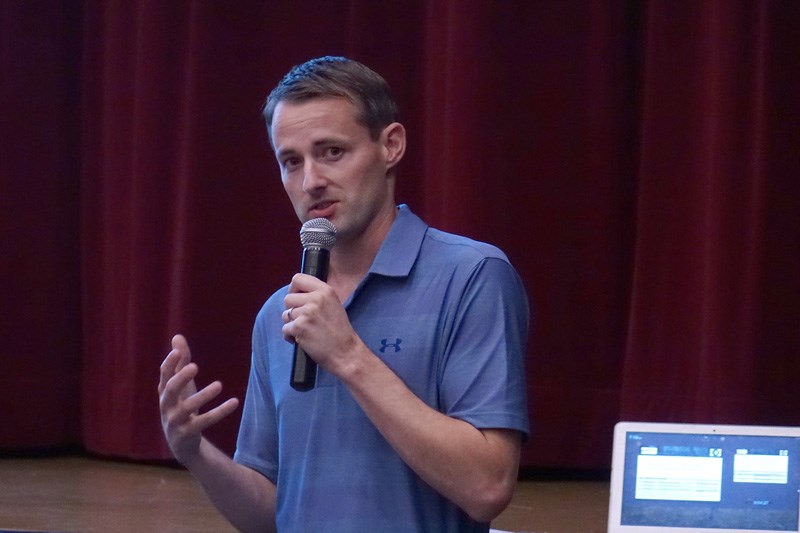Students and adults got a crash course in concussions from neurosurgeon Dr. Michael Ellis on Sept. 14 during a pair of lectures at the Letkemann Theatre.
Ellis works with the Pan Am Clinic in Winnipeg, which sees about 40 to 85 children and youth a week with suspected concussions, sometimes but not always the result of playing sports.
A concussion, Ellis said, is a type of brain injury in which there is not physical damage to the organ but pronounced effects on its function.
“There’s not really structural damage to the brain,” Ellis told the audience at his evening lecture, which followed one to R.D. Parker Collegiate students in the afternoon. “The brain just doesn’t work properly for a short period of time so often times, when adults have concussions, they have a bunch of symptoms fairly rapidly and then they just kind of go away over time.”
Most of the concussions treated through the Pan Am Clinic’s concussion program, a partnership with the Health Sciences Centre Children’s Hospital, the University of Manitoba and the Winnipeg Regional Health Authority, are the result of playing hockey, though Ellis says that isn’t so much a reflection of the danger of the sport as of its popularity in Canada. Concussions also occur in sports such as soccer, cheerleading and synchronized swimming, and from other causes like motor vehicle accidents, assaults and falls.
“You don’t actually have to hit your head to have a concussion,” Ellis said. “Some of those forces are high enough to be transmitted to the brain even though the head’s impacted.”
Part of the problem of diagnosing concussions, he said, is that there are not objective tests to determine if a patients has one and they may not recognize the symptoms themselves or be willing to report them, especially in the case of athletes for whom doing so would mean not being able to play again until they are symptom-free.
Professional athletes may recover from a concussion in as little as one or two weeks, but that isn’t an indication of how long it may take a younger patient.
“Often times with kids it takes longer than that,” Ellis said, in the range of 20 to 25 days, and they have to be reintroduced to their previous activities, even school, gradually.
One of the dangers with a concussion going unrecognized and untreated is that a subsequent concussion may have a much more severe effect. People who receive a second concussion before they have recovered from an initial one take about twice as long to recover and can even suffer second impact syndrome, when the brain can’t regulate blood flow, which is treated by removing part of the patient’s skull. A 15-year-old girl in Ottawa who got a concussion playing rugby died as a result of second impact syndrome, though Ellis said there hasn’t been a case in Manitoba since 1997.
Noting that his talk was specifically aimed at athletes and coaches, Ellis said the best thing to do is to exercise caution.
“Nobody expects you guys to be doctors,” he said.
In recognition of the fact that it can be difficult to receive timely treatment outside of the city, the Pan Am concussion program is hoping to set up teleconferencing capabilities so that they can see people who may have suffered concussions in remote and rural areas as quickly as possible.
“It hopefully will be up and running in the next month or so,” Ellis said.
Responding to an audience question, Ellis said it appears that females are actually more susceptible to concussions than males, even though most of the concussions they treat at the clinic have happened to males.
“Our female athletes tend to have more severe symptoms when we do [see them,]” said Ellis. “They sometimes can take a bit longer to recover.”
As for people with previous concussions becoming more susceptible to another one afterwards, Ellis said that was difficult to prove as a hard rule.
In about 30 per cent of concussions in children and youth, Ellis said, symptoms may not appear for a day or two.
He declined to say what age it would be appropriate to introduce bodychecking in hockey but did say it probably isn’t necessary in most leagues.
“Do I think that kids who are playing single A and high school need to be slamming each other into the boards when they have absolutely no hope of making a living playing hockey? Probably not,” he said.
Ellis, whose brother Dan Ellis played 13 years as a goaltender in the National Hockey League, responded to another question about whether hockey goaltenders could get a concussion as a result of taking a shot in the mask by saying that it is possible and if symptoms such as headaches persist for more than a few seconds or reappear after the game, that would be reason to seek treatment.
“We’re trying to build on the idea that it’s probably better to err on the side of caution without being completely crazy and taking every kid off the ice,” said Ellis.




